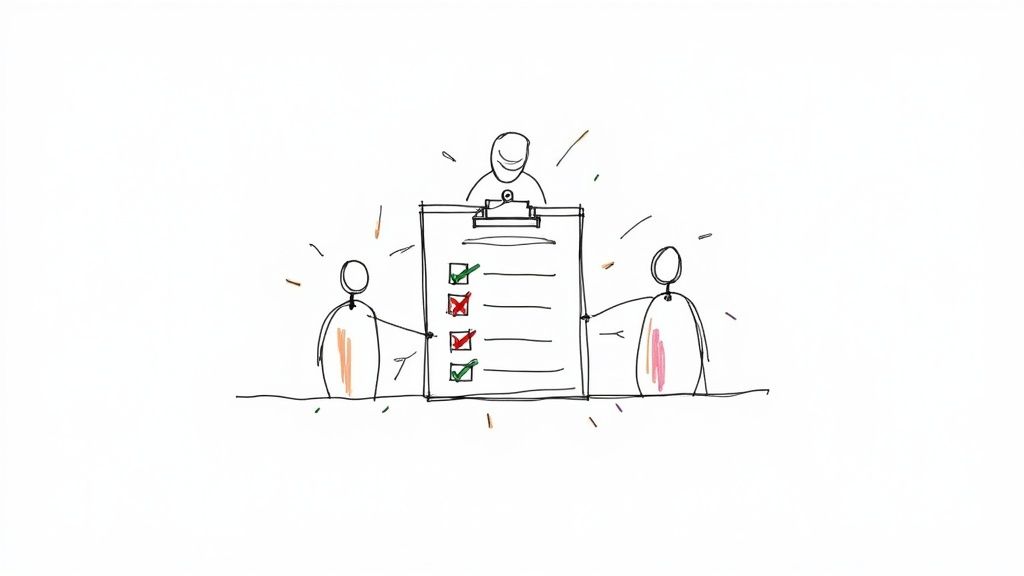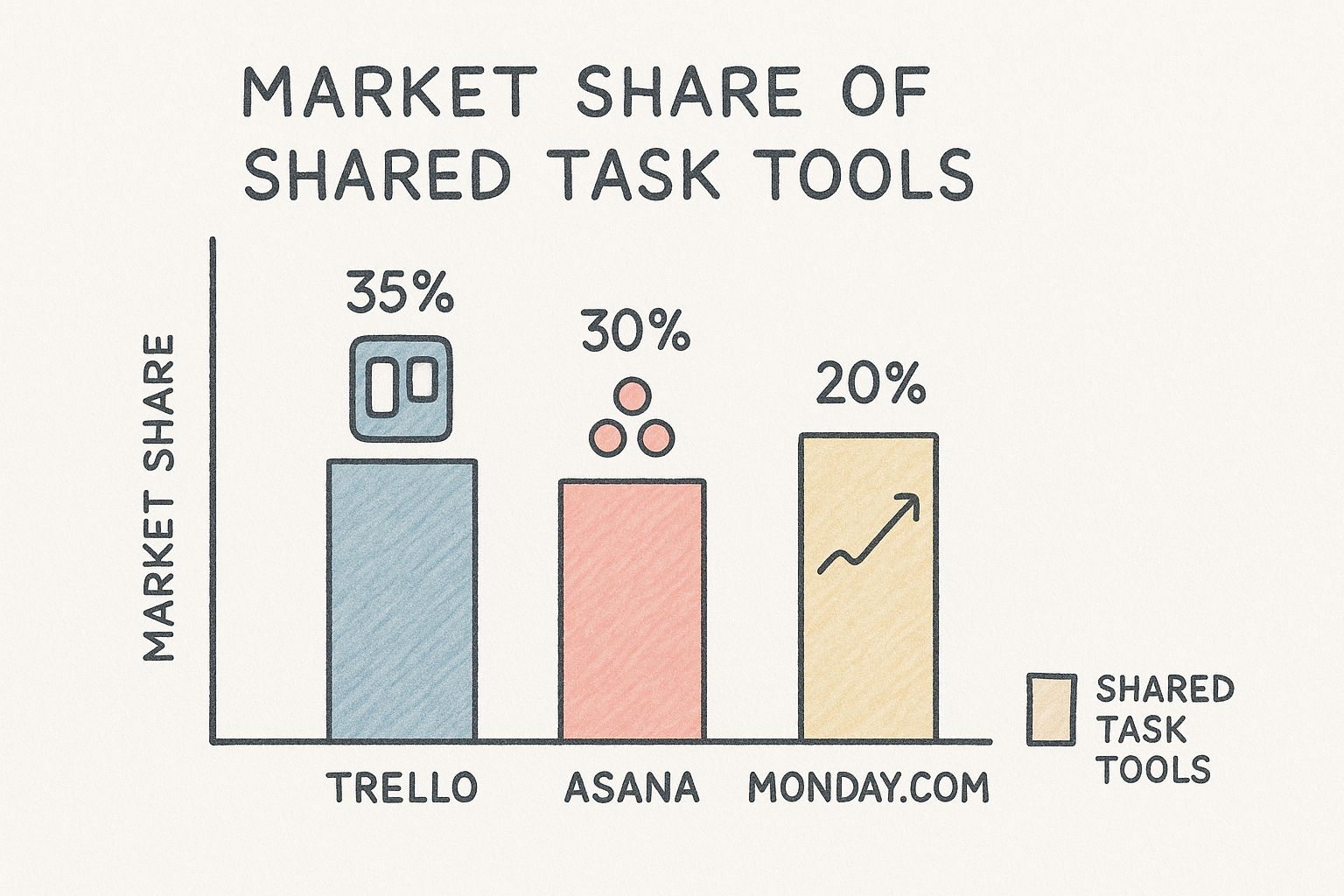
Share Task List Like a Pro: Master Team Collaboration
Master how to share task list effectively with your team. Discover proven strategies, top tools, and workflows that boost productivity instantly.

Why Teams Struggle Without Proper Task List Sharing

Imagine a kitchen where everyone is preparing a dish for the same meal, but no one knows what anyone else is making. This often mirrors the reality of teams lacking a shared task list. Confusion takes over, resources are wasted, and the final product suffers. This absence of task transparency presents significant obstacles to a team's success.
One major issue is duplication of effort. Without a clear overview of responsibilities, multiple team members might inadvertently work on the same task. This wastes valuable time and resources, potentially leading to frustration among team members and hindering overall project progress.
Another common problem is missed deadlines. When tasks aren't clearly assigned and monitored, tracking progress and identifying potential delays becomes difficult. Projects can fall behind schedule, impacting the entire team's performance. A lack of shared visibility makes it challenging to adapt to unforeseen circumstances.
Poor communication is yet another consequence. Without a central hub for task-related information, communication becomes fragmented. Crucial updates get lost in email chains or individual chats. This lack of clarity leads to confusion and errors. One team member might be waiting on another, unaware of a reassignment or delay.
The increasing importance of task management is reflected in the growth of the task management software market. In 2025, this market was valued at USD 2.5 billion and is projected to reach USD 7.1 billion by 2027, a CAGR of 13.90%. This growth is fueled partly by a global surge in the number of SMEs, which reached roughly 212.98 million in 2025. More detailed statistics can be found here: Learn more about task management software statistics.
The Hidden Costs of Working in Silos
Working in silos, where information isn't shared openly, creates hidden costs that significantly impact productivity and morale.
Decreased Accountability: When task assignments aren't clear and visible to the entire team, accountability suffers. It becomes easier for tasks to fall through the cracks.
Increased Stress and Burnout: The constant uncertainty and struggle to manage tasks in isolation increase stress and burnout among team members, negatively affecting individual well-being and team dynamics.
Reduced Innovation and Collaboration: Silos stifle the flow of ideas and hinder collaboration. This limits innovation and prevents teams from maximizing their potential. A shared task list fosters a collaborative environment where everyone can learn from each other.
By implementing a reliable system for task list sharing, teams can avoid these issues and build a more efficient and collaborative work environment. Embracing task transparency can significantly improve team performance.
Proven Methods to Share Task Lists With Your Team

Sharing a task list is more than just checking things off; it's about building a collaborative environment where everyone is informed. Choosing the right sharing method is key to maximizing team productivity. Let's explore some proven strategies that empower teams to stay organized and maintain clear visibility.
Digital-First Approaches for Seamless Collaboration
Digital-first approaches are ideal for teams that thrive in the digital world. They offer seamless collaboration and real-time updates. Project management software like Asana, Trello, or Monday.com provides centralized task management, assignment, and progress tracking. This keeps everyone in the loop and minimizes duplicated efforts or miscommunication. For instance, assigning tasks within these platforms establishes clear ownership and accountability.
Integrating these tools with communication platforms like Slack further streamlines workflows. Updates and notifications are sent directly to the team's communication channels, eliminating the need for constant email checks or status meetings. This centralized system makes it easier to adapt to changes and maintain momentum.
Hybrid Systems for Blended Work Environments
Not all teams work exclusively in the digital space. Hybrid systems, which combine digital tools with traditional methods like whiteboards or physical Kanban boards, can be a great solution for blended work environments. See How to master Kanban tasks for more information on this approach. This blend provides both the flexibility of digital tracking and the visual clarity of physical boards.
This approach works particularly well for teams that value face-to-face interaction. Regular check-ins around a physical Kanban board encourage discussion and quick problem-solving, while the digital component provides a record of decisions and progress. This accommodates different communication preferences and work styles.
Specialized Methods for Unique Team Dynamics
Understanding your team's specific dynamics is vital for choosing the most effective method. Some teams may benefit from specialized approaches. For example, a team handling a complex project might use a Gantt chart for detailed timeline management and dependency tracking. This offers a comprehensive visual representation of the project’s progress, enabling better planning and risk management.
A smaller team with a fast-paced workflow might opt for a shared spreadsheet. This allows for rapid updates and easy visibility without the overhead of complex project management software. The key is to choose a method that aligns with the team's size, project complexity, and working style. This ensures seamless task management and fosters collaboration.
Best Tools and Platforms to Share Task Lists Effectively

The infographic above shows how the market share is divided among the most popular shared task list platforms. Trello leads the way with 35%, followed by Asana at 30% and Monday.com at 20%. This data clearly demonstrates that these three platforms hold a substantial part of the market. Their popularity suggests they are effective tools for managing shared task lists.
Choosing the right platform is essential for successful task sharing. Consider factors like the size of your team, the scope of the project, and your budget.
Teams need to carefully evaluate their specific needs before deciding on a platform. A small team working on a straightforward project might find a simple shared spreadsheet is enough. Larger teams with more complex projects will likely need a more robust platform. These platforms often include features like Gantt charts and dependency tracking.
Key Features to Consider When Choosing a Platform
Finding the best tool for effective task list sharing depends on a number of factors. Here are some essential features to keep in mind:
Intuitive Interface: A user-friendly interface is crucial for quick adoption and efficient task management. A complicated interface can lead to frustration and discourage team members from using the tool.
Collaboration Features: Real-time updates, comment sections, and shared workspaces are vital for smooth collaboration. These features keep everyone informed and allow them to contribute effectively.
Integration Capabilities: Integrating your task management platform with your existing tools can significantly improve workflows. Consider connecting it with your calendar or communication platform to reduce app switching and consolidate information.
Customization Options: The ability to customize your task list view, prioritize tasks, and create custom workflows is key. It allows you to tailor the platform to your team's unique needs.
Pricing and Scalability: Look at the pricing structure and ensure the platform can grow with your team. What works for a small team now might not be suitable as the team or project expands.
To help you compare some of the most popular platforms, take a look at the table below. It summarizes the key features, pricing, and ideal use cases of each platform.
Task Management Platform Comparison
Comparison of popular task management platforms and their sharing capabilities, pricing, and key features.
| Platform | Sharing Features | Team Size | Price Range | Best For |
|---|---|---|---|---|
| Trello | Boards, lists, cards, comments, attachments | Small to medium | Free - $17.50/user/month | Visual project management |
| Asana | Projects, tasks, subtasks, comments, attachments, custom fields | Small to large | Free - $30.49/user/month | Comprehensive project management |
| Monday.com | Customizable boards, views, automations, integrations | Small to large | Free - $16/user/month | Highly customizable workflows |
| Google Tasks | Shared lists, due dates | Individuals and small teams | Free | Basic task management within Google Workspace |
The table above provides a quick overview of popular task management platforms and their strengths. Remember to consider your team’s specific needs when making your final decision.
Popular Task Management Platforms
There are many tools available for sharing task lists, each with its own advantages and disadvantages.
Trello: Known for its visual Kanban board approach, Trello is excellent for visualizing workflow. It is particularly useful for managing tasks as they move through different stages.
Asana: Asana is a complete project management tool. It provides powerful features for managing tasks, improving communication, and facilitating collaboration.
Monday.com: Monday.com offers a highly customizable platform. It can adapt to various project types and team sizes.
Google Tasks: Integrated with the Google Workspace ecosystem, Google Tasks is a simple, free solution. It's useful for individual task management and basic sharing. You might be interested in: How to add tasks to Google Calendar.
The global task management software market, including platforms for sharing task lists, has grown significantly. In 2018, the market size was approximately USD 1713.0 million. It's projected to reach USD 4535.5 million by 2026, with a CAGR of roughly 13%. You can find more detailed statistics here: Explore this topic further. This growth underscores the increasing demand for effective task management solutions, with shared task lists being a critical factor in team productivity.
Building Workflows That Actually Work for Task Sharing
Sharing a task list is a great first step, but it's only the beginning. The real power comes from building workflows that truly support effective task sharing. This means creating systems that are not only efficient but also adaptable to the dynamics of teamwork. It requires understanding your team’s work style and creating systems that complement their collaboration.
Establishing Clear Ownership Without Micromanaging
A key component is establishing clear ownership. Every task needs a designated owner, someone clearly responsible for seeing it through to completion. However, this shouldn’t devolve into micromanagement. Instead, the goal is to empower team members to take true ownership, not to create a rigid and overly controlled environment. This balance fosters both autonomy and accountability.
Creating Processes People Actually Follow
Effective workflows aren't built on abstract theories; they're built on how people actually work. Processes should be intuitive and user-friendly. If a system is too complicated or cumbersome, it will often be ignored, leading right back to the problems a shared task list was meant to solve. Keep it simple and align processes with the team's existing habits.
Building Flexibility Into Your Workflows
Projects rarely unfold exactly as planned. Building flexibility into workflows is crucial. This might mean having backup plans for essential tasks or using a system that can easily adapt to changes. Adaptability allows teams to effectively handle unexpected roadblocks, keeping projects moving forward.
Essential Elements of a Successful Workflow
A truly successful workflow for task sharing includes several key elements:
Task Categorization: Use categories that are relevant and meaningful to your team. This makes it easier to organize and filter tasks, providing quick access to the information everyone needs.
Priority System: A clear priority system ensures everyone understands which tasks demand immediate attention. This helps the team focus on the most crucial objectives and minimizes confusion.
Communication Protocols: Define how task-related communication will occur. Perhaps this means using a dedicated communication channel like Slack or establishing a specific format for updates. Learn more in our article about How to share Google Tasks. Clear communication protocols prevent information overload and keep everyone in the loop.
Onboarding Strategies: Make it easy for new team members to understand and utilize the shared task list and workflow. This accelerates their integration into the team and reduces the initial learning curve.
By incorporating these elements and prioritizing practicality and adaptability, you can create workflows that genuinely enhance your team's task-sharing capabilities. The result is a more efficient and collaborative work environment, ultimately leading to better project outcomes.
Overcoming Challenges When You Share Task List

Sharing a task list offers significant advantages for team collaboration. However, just like any joint effort, it also presents some distinct challenges. These can range from minor misunderstandings to more complex issues involving team dynamics and workflow structure. Successfully addressing these obstacles is essential for effective teamwork and maximizing the benefits of shared task lists.
Information Overload and Communication Breakdowns
One common hurdle is information overload. An excessive number of notifications, updates, and comments can easily overwhelm team members. This can lead to missed information, creating confusion regarding task assignments, deadlines, and progress.
For instance, a team member might overlook a crucial update buried within a long email thread, causing project delays or duplicated work. Effective strategies for filtering and prioritizing communication are crucial. The goal is to ensure the right information reaches the right people at the right time.
Unclear Accountability and Resistance to New Systems
Another frequent challenge is unclear accountability. When responsibilities aren't clearly defined within the shared task list, tasks can be forgotten or neglected. This can result in frustration and tension within the team.
Furthermore, some team members might display resistance to new systems. Transitioning to a new task-sharing method requires adapting habits and workflows. This can be difficult, especially for teams accustomed to traditional methods. Therefore, providing comprehensive training and support is essential for successful adoption.
Managing Competing Priorities and Maintaining Consistency
Teams frequently manage multiple projects at the same time, each with its own set of priorities. This can make it difficult to manage competing priorities and allocate resources effectively within a shared task list.
Maintaining consistency in task management practices also poses a challenge. The initial enthusiasm for a new system can decrease over time, resulting in inconsistent usage and reducing the advantages of a shared task list. Regularly reinforcing the system's benefits and addressing any new challenges is vital for continued engagement.
Handling Different Personality Types
Teams are made up of individuals with diverse personalities and work styles. This variety can sometimes create friction when sharing a task list. Some team members might prefer a highly structured approach, while others might prefer more flexibility.
Understanding and accommodating these different personality types is crucial for fostering a collaborative and productive work environment. Offering different views and customization options within the shared task list can cater to individual preferences and improve team harmony.
Troubleshooting and Getting Everyone Back on Track
Even with careful planning, issues will inevitably occur. Having strategies for troubleshooting problems and getting everyone back on track is paramount. This might involve regular check-in meetings, dedicated communication channels for raising concerns, or a flexible review process to adapt workflows based on feedback.
Proactively identifying and addressing challenges prevents minor issues from becoming major obstacles. This proactive approach ensures the shared task list remains a valuable tool for improving teamwork and achieving project success.
Advanced Strategies for Scaling Task List Collaboration
Successfully sharing a task list is the foundation of efficient teamwork. However, as teams and projects grow, basic task sharing isn't enough. This is where advanced strategies for scaling task list collaboration become essential for maintaining efficiency and clarity, even as complexity increases.
Intelligent Task Routing and Dynamic Priority Management
Think about implementing intelligent task routing, where tasks are automatically assigned based on pre-set criteria like skill set, availability, or current workload. This removes the need for manual assignments and ensures tasks quickly reach the most suitable team member.
Dynamic priority management is another key component. This involves a system that automatically adjusts task priorities based on factors like deadlines, dependencies, or evolving project needs. This keeps the team focused on the most time-sensitive tasks, even when circumstances change.
Cross-Functional Collaboration and Strategic Integrations
For organizations with several departments, cross-functional collaboration is vital. Shared task lists can bridge the communication gap between teams, facilitating coordination on joint projects. For example, a marketing team could share a task list with the sales team to ensure everyone is on the same page about campaign timelines and deliverables.
Strategic integrations link your task management system with other essential business tools like a CRM. This creates seamless workflows that reduce manual effort and enhance accuracy. For example, when a sales representative closes a deal, a task could be automatically generated for the fulfillment team to process the order.
Leveraging Insights From Shared Task Data
The data generated from shared task lists offers invaluable insights. Analyzing this data can help you pinpoint bottlenecks, optimize team performance, and make informed decisions about resource allocation. For example, tracking task completion times can highlight areas where processes are slowing down, prompting targeted improvements.
Scaling Practices and Maintaining Effectiveness
As your team grows, scaling these practices is essential. This involves setting up systems and processes that can handle an increasing number of users and projects without sacrificing efficiency.
Maintaining effectiveness across multiple projects simultaneously requires clear organization and smart prioritization. Using project-specific task lists alongside an overarching view of all current projects can help teams stay focused and prevent conflicts. This approach promotes efficient resource allocation and a balanced workload distribution across different initiatives.
To illustrate a structured approach to implementing these advanced practices, let's look at a sample timeline. The table below outlines key phases, timelines, activities, and metrics for successful implementation across teams of varying sizes.
Introducing the "Task Sharing Implementation Timeline," a step-by-step guide for implementing effective task sharing in teams of all sizes.
| Phase | Timeline | Key Activities | Success Metrics | Team Size |
|---|---|---|---|---|
| Assessment | 1-2 weeks | Analyze current workflows, identify pain points, define goals. | Clear understanding of current state and desired outcomes. | All |
| Tool Selection | 1-2 weeks | Evaluate and select appropriate task management platform. | Chosen platform aligns with team needs and budget. | All |
| Implementation | 2-4 weeks | Configure platform, train team members, establish workflows. | Smooth transition to new system, high user adoption rate. | Small to medium |
| Optimization | Ongoing | Monitor performance, gather feedback, refine processes. | Continuous improvement in team productivity and collaboration. | All |
| Scaling | As needed | Adapt workflows and tools to accommodate growth. | Maintained efficiency and clarity despite increased complexity. | Medium to large |
This structured approach, as illustrated in the table, facilitates a smoother transition to more advanced task sharing. Ultimately, this allows teams to fully realize the potential of collaborative task management, resulting in greater efficiency and productivity.
Measuring and Optimizing Your Task Sharing Success
Sharing your task list isn't a one-time action; it's an ongoing process that requires constant nurturing and refinement. Think of it like cultivating a garden: you plant the seeds (share the list), but continuous watering, weeding, and pruning are essential for a thriving harvest (achieving your goals). This means looking beyond simply checking off completed tasks and focusing on metrics that reveal the true impact of task sharing on your team's collaboration and overall success.
Key Performance Indicators (KPIs) for Task Sharing
Key Performance Indicators (KPIs) provide valuable insights into the effectiveness of your task-sharing practices. These metrics offer quantifiable data that you can use to track progress, pinpoint areas for improvement, and demonstrate the value of your efforts.
Task Completion Rate: While not the only measure of success, monitoring the task completion rate helps identify potential bottlenecks. A consistently low completion rate might signal issues with resource allocation, task clarity, or workflow efficiency.
Time to Completion: Measuring the time it takes to complete tasks allows you to assess overall productivity. If tasks consistently exceed anticipated timelines, it could suggest process inefficiencies or skill gaps requiring attention.
Collaboration Quality: Evaluate the quality of communication within shared task lists. Consider factors like response times to comments and the clarity of updates. This qualitative data provides insights into team dynamics and identifies communication barriers.
Team Satisfaction: Regularly gather feedback from team members regarding their experience with the shared task list system. This can be accomplished through surveys, interviews, or informal check-ins. Understanding team satisfaction is crucial for ensuring sustained engagement and system adoption.
Practical Frameworks for Gathering Authentic Feedback
Establishing a system for gathering authentic feedback is essential for continuous improvement. This feedback loop allows you to identify both successful strategies and areas needing adjustment.
Regular Check-ins: Implement short, focused check-in meetings specifically dedicated to discussing the task-sharing process. These meetings offer a platform for team members to share their experiences and voice any concerns.
Anonymous Surveys: Distributing anonymous surveys empowers team members to provide honest feedback without feeling pressured. This method is particularly valuable for gathering sensitive information about team dynamics and potential conflicts.
Usage Pattern Analysis: Many task management platforms, such as Asana, offer analytics that provide valuable insights into usage patterns. Data such as the frequency of task updates, comment activity, and overall platform engagement can reveal how effectively the system is being used.
Creating Sustainable Optimization Processes
Optimization is not a one-time solution but a continuous process. Building a sustainable optimization process ensures your task-sharing practices remain effective and adapt to your team's evolving needs.
Establish a Review Cycle: Set a regular schedule for reviewing your task-sharing KPIs and feedback data. This could be monthly, quarterly, or annually, depending on your work pace.
Prioritize Improvement Opportunities: Based on the gathered data, prioritize the improvement opportunities with the greatest potential impact. This focused approach prevents feeling overwhelmed and ensures the most significant issues are addressed first.
Document Changes and Track Progress: Maintain a record of all modifications made to your task-sharing system. This documentation allows you to monitor the impact of each change and provides valuable insights for future optimization efforts.
By prioritizing these metrics and establishing a robust system for gathering feedback and implementing improvements, you can cultivate a task-sharing ecosystem that drives productivity, enhances collaboration, and delivers measurable value. Continuously optimizing your task-sharing practices ensures your team remains adaptable and efficiently achieves its objectives.
Ready to transform your team's task management? Visit Tooling Studio and discover powerful tools that seamlessly integrate with Google Workspace to enhance collaboration and boost productivity.